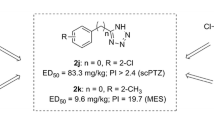Abstract
A series of new benzimidazole derivatives (4a–p) were synthesized and evaluated for anticonvulsant activity in albino mice against two most adopted models, i.e. maximal electroshock seizure (MES)- and subcutaneous pentylenetetrazole (scPTZ)-induced seizures. Synthesized compounds were also screened for possible neurotoxicity using rotarod test. Among the synthesized compounds, 4p showed the most promising activity in MES and scPTZ screens, which was further subjected for oral activity in rats. At a dose of 30 mg/kg, it showed tremendous activity in the scPTZ screen. The acute toxicity study (LD50) of compounds showed that only two tested compounds 4f and 4m did not produce any mortality at any of the dose level. Molecular properties and pharmacokinetic parameters of the titled compounds were also determined using Lipinski’s rule of five. The promising results encourage future investigation on the rational modification of this nucleus for development of better compounds.




Similar content being viewed by others
References
Anelia TM, Kamelya KA, Dimitar IV, Jordan AT, Pavletta SD, Magdalena SK, Mitka KM (2006) Antihelminthic activity of some newly synthesized 5(6)-(un)substituted-1H-benzimidazol-2-ylthioacetylpiperazine derivatives. Eur J Med Chem 41:1412–1420
Auberson YP (2001) Competitive AMPA antagonism: a novel mechanism for antiepileptic drugs. Drugs Fut 26:463–471
Blaszczak-Swiqtkiewicz K, Mikiciuk-Olasik E (2015) Some characteristics of activity of potential chemotherapeutics–benzimidazole derivatives. Adv Med Sci 60:125–132
Brauner-Osborne H, Egebjerg J, Nielsen EO, Adsen U, Krogsgaard-Larsen P (2000) Ligands for glutamate receptors: design and therapeutic prospects. J Med Chem 43:2609–2645
Castro AR, Rivera IL, Rojas LC, Vazquez GN, Rodríguez AN (2011) Synthesis and preliminary evaluation of selected 2-aryl-5 (6)-nitro-1H-benzimidazole derivatives as potential anticancer agents. Arch Pharm Res 34:181–189
Cole ER, Crank G, Salam-Sheikh A (1974) Antioxidant properties of benzimidazoles. J Agric Food Chem 22:918
Danysz W, Parsons CG (1998) Glycine and N-methyl-d-aspartate receptors: physiological significance and possible therapeutic applications. Pharmacol Rev 50:597–664
Dimmock JR, Puthucode RN, Smith JM, Hetherington M, Quail JW, Pugazhenthi U, Lechler T, Stables JP (1996) (Aryloxy)aryl semicarbazones and related compounds: a novel class of anticonvulsant agents possessing high activity in the maximal electroshock screen. J Med Chem 39:3984–3997
Dingledine R, Borges K, Bowie D, Traynelis SF (1999) The glutamate receptor ion channels. Pharmacol Rev 51:7–61
Donati D, Micheli F (2000) Recent development in glycine antagonists. Exp Opin Ther Patents 10:667–673
Dunham NW, Miya TA (1957) A note on a simple apparatus for detecting neurological deficit in rats and mice. J Am Pharm Assoc Sci 46:208–209
Hu L-Y, Boxer PA, Kesten SR, Lei HJ, Wustrow DJ, Moreland DW, Zhang L, Ahn K, Ryder TR, Liu X, Rubin JR, Fahnoe Kelly, Carroll RT, Dutta S, Fahnoe DC, Probert AW, Roof RL, Rafferty MF, Kostlan CR, Scholten JD, Hood M, Ren X-D, Schielke GP, Su T-Z, Taylor CP, Mistry A, McConnell P, Hasemann C, Ohren J (2006) The design and synthesis of human branched-chain amino acid aminotransferase inhibitors for treatment of neurodegenerative diseases. Bioorg Med Chem Lett 16:2337–2340
Iemura R, Kawashima T, Fukuda T, Ito K, Tsukamoto G (1986) Synthesis of 2-(4-substituted-1-piperazinyl)benzimidazoles as H1-antihistaminic agents. J Med Chem 29:1178–1183
Jun C, Jiangtao X, Xianjin L (2005) Synthesis and antiviral activity against Coxsackie virus B3 of some novel benzimidazole derivatives. Bioorg Med Chem Lett 15:267–269
Kaur G, Kaur M, Silakari O (2014) Benzimidazoles: an ideal privileged drug scaffold for the design of multitargeted anti-inflammatory ligands. Mini Rev Med Chem 14:747–767
Krall RL, Penry JK, White BG, Kupferberg HJ, Swinyard EA (1978) Antiepileptic drug development: II. Anticovulsant drug screening. Epilepsia 19:409–428
Kruse LI, Ladd DL, Harrsch PB, McCabe FL, Mong SM, Faucette L, Johnson R (1989) Synthesis, tubulin binding, antineoplastic evaluation, and structure-activity relationship of oncodazole analogs. J Med Chem 32:409–417
Kubo K, Kohara Y, Yoshimura Y, Inada Y, Shibouta Y, Furukawa Y, Kato T, Nishikawa K, Naka T (1993) Nonpeptide angiotensin II receptor antagonists. Synthesis and biological activity of potential prodrugs of benzimidazole-7-carboxylic acids. J Med Chem 36:2343–2349
Kulagowski JJ (1996) Glycine-site NMDA receptor antagonists: an update. Exp Opin Ther Patents 6:1069–1079
Kulagowski JJ, Leeson PD (1995) Glycine-site NMDA receptor antagonists. Exp Opin Ther Patents 5:1061–1075
Lees GJ (2000) Pharmacology of AMPA/kainate receptor ligands and their therapeutic potential in neurological and psychiatric disorders. Drugs 59:33–78
Leeson PD, Iversen LL (1994) The glycine site on the NMDA receptor: structure-activity relationships and therapeutic potential. J Med Chem 37:4053–4067
Litchfield JT, Wilcoxon FA (1949) A simplified method of evaluating dose-effect experiments. J Pharmacol Exp Ther 96:99–113
Porcari AR, Devivar RV, Kucera LS, Drach JC, Townsend LB (1998) Design, synthesis, and antiviral evaluations of 1-(substituted benzyl)-2-substituted-5,6-dichlorobenzimidazoles as nonnucleoside analogues of 2,5,6-trichloro-1-(β-d-ribofuranosyl)benzimidazole. J Med Chem 41:1252–1262
Sander JW (2003) The epidemiology of epilepsy revisited. Curr Opin Neurol 16:165–170
Sarro GD, Gitto R, Russo E, Ibbadu GF, Barreca ML, Luca LD, Chimirri A (2005) AMPA receptor antagonists as potential anticonvulsant drugs. Curr Top Med Chem 5:31–42
Schrödinger Release 2015-1 (2015a) Maestro, version 9.8, Schrödinger, LLC, New York, NY
Schrödinger Release 2015-1 (2015b) Schrödinger Suite 2014-2 Protein preparation wizard; Epik version 2.8, Schrödinger, LLC, New York, NY, 2014; Impact version 6.3, Schrödinger, LLC, New York, NY, 2015; Prime version 3.5, Schrödinger, LLC, New York, NY, (2015)
Swinyard EA, Woodhead JH, White HS, Franklin MR (1989) Antiepileptic drugs, 3rd edn. Raven-Press, New York, pp 85–102
Acknowledgments
Authors are thankful to National Institute of Neurological Disorders and Stroke (NINDS) for pharmacological work and Dr. Ozair Alam for performing molecular docking study.
Author information
Authors and Affiliations
Corresponding author
Ethics declarations
Conflict of interest
Authors declare no conflict of interest.
Electronic supplementary material
Below is the link to the electronic supplementary material.







Rights and permissions
About this article
Cite this article
Siddiqui, N., Alam, M.S., Ali, R. et al. Synthesis of new benzimidazole and phenylhydrazinecarbothiomide hybrids and their anticonvulsant activity. Med Chem Res 25, 1390–1402 (2016). https://doi.org/10.1007/s00044-016-1570-6
Received:
Accepted:
Published:
Issue Date:
DOI: https://doi.org/10.1007/s00044-016-1570-6




